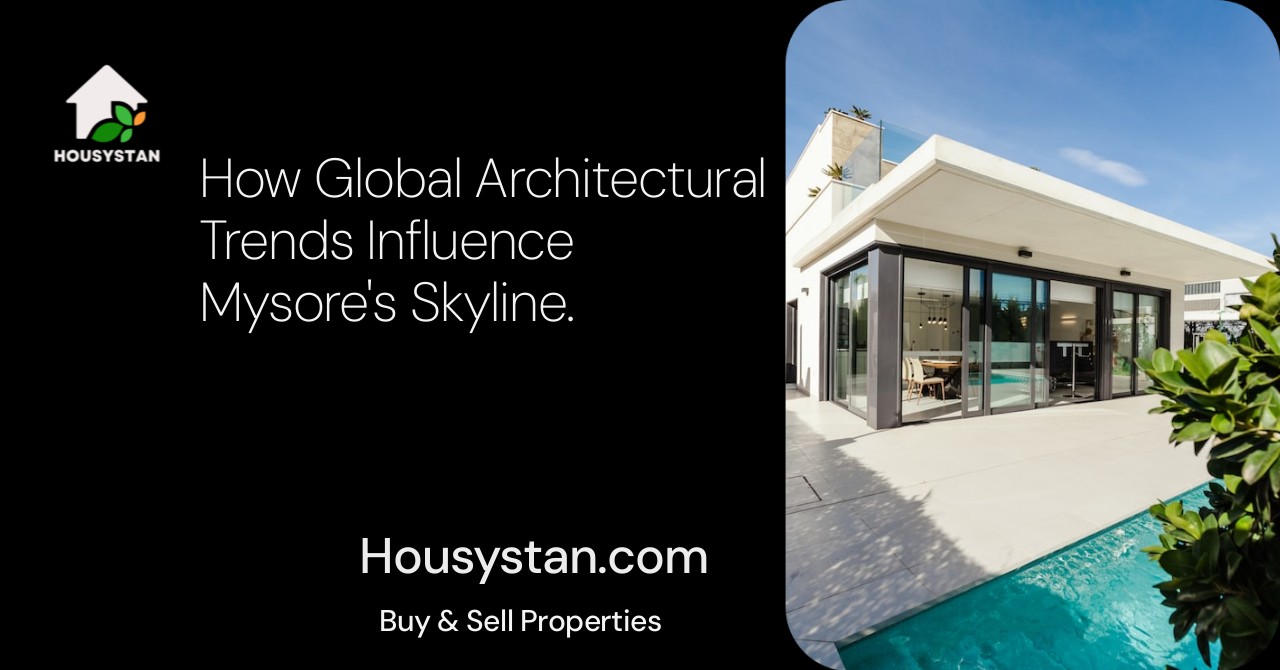How Global Architectural Trends Influence Mysore's Skyline
Read latest blogs and articles from Housystan

The Information mentioned here was last updated on:
18/12/2025How Global Architectural Trends Influence Mysore's Skyline
The city of Mysore, known for its rich history and cultural heritage, has always been a treasure trove of architectural delights. From the stunning Mysore Palace to the beautiful Chamundi Hills, the city reflects a harmonious blend of traditional and modern influences. In recent years, however, Mysore’s skyline has been undergoing a transformation, as global architectural trends begin to leave their mark. This article explores how global architectural styles are shaping Mysore’s skyline, making it a modern urban marvel while retaining its historical charm.
The Rise of Sustainable Architecture
- Verified Tenants/Buyers
- Unlimited Property Listing
- Zero subscription/charges fee
In the past decade, sustainability has become a key trend in architecture around the globe. With the growing awareness of environmental issues, architects are now prioritizing eco-friendly designs. This global trend has made its way to Mysore, where architects are incorporating green technologies and sustainable building practices into new constructions.
Green roofs, rainwater harvesting systems, and solar panels are increasingly common in Mysore's new buildings. These sustainable designs not only reduce the carbon footprint but also help in maintaining a balanced ecological system. Mysore is embracing these changes, showcasing how modern sustainability can coexist with architectural heritage.
Minimalist Design Philosophy
Minimalism, characterized by simplicity and functionality, has become a global architectural phenomenon. This design philosophy emphasizes clean lines and open spaces, focusing on essentials and eliminating unnecessary details. Its influence can be seen in Mysore’s new residential and commercial projects.
Developers in Mysore are adopting minimalist designs that offer a sleek and modern aesthetic. Buildings feature large windows, seamless interiors, and neutral color palettes. This trend is popular because it enhances the functionality of spaces while offering a serene and uncluttered environment, appealing to the younger generation who value simplicity and efficiency in their living spaces.
The Influence of Smart Technology
Incorporating smart technology into buildings is a rapidly growing trend worldwide. This shift towards smart architecture integrates advanced technology solutions into building designs, enhancing the convenience and comfort of living spaces. Mysore is no exception to this trend, as more developers are introducing tech-friendly features in both residential and commercial properties.
Smart homes in Mysore now include automated lighting, climate control systems, smart security features, and voice-controlled appliances. These technologies not only offer high levels of convenience but also improve energy efficiency, aligning with the sustainable architecture movement. By embracing smart technology, Mysore is stepping into the future while ensuring that its infrastructure supports modern lifestyles.
Revival of Traditional Elements
Despite the influx of global architectural trends, there is a growing movement to revive and preserve traditional elements in Mysore's architecture. This trend reflects a broader global appreciation for cultural heritage and artisanal craftsmanship, which has influenced architectural styles around the world.
In Mysore, architects are finding innovative ways to incorporate traditional designs and materials into modern structures. This includes the use of local stone carvings, ornate wooden details, and the integration of traditional Vastu principles in building layouts. By reviving these elements, Mysore ensures that its evolving skyline pays homage to its rich cultural legacy.
Integration of Open Spaces
Globally, urban planning is increasingly focusing on integrating open and green spaces within city environments. This trend has found its way to Mysore, impacting its architectural landscape significantly. Urban developers are now prioritizing open areas within residential complexes and office spaces, offering inhabitants opportunities for recreation and relaxation.
In Mysore, the incorporation of gardens, terraces, and communal spaces in new developments helps reduce the urban heat island effect and promotes biodiversity. These open spaces contribute to the overall well-being of inhabitants, enhancing the quality of urban life. They also add aesthetic value, allowing buildings to blend harmoniously with the natural landscape of Mysore.
Adoption of Modern Materials
The use of modern construction materials is another global trend influencing Mysore's skyline. High-performance materials such as engineered wood, composite panels, and energy-efficient glass are increasingly being used in new building projects across the city. These materials provide durability, flexibility, and improved energy efficiency.
In Mysore, the adoption of such materials is driven by the need to meet modern building standards while respecting the city’s architectural heritage. For instance, energy-efficient glass not only reduces energy consumption but also enhances the aesthetic appeal of a building. By using cutting-edge materials, Mysore balances tradition with innovation.
Emphasis on Mixed-Use Developments
Mixed-use developments have become a prominent trend in urban planning globally, aiming to create spaces that serve multiple purposes, such as residential, commercial, and recreational. This concept is gaining traction in Mysore, with several mixed-use projects underway.
These developments promote a sense of community and reduce the need for long commutes by combining living spaces with work and leisure facilities in one location. In Mysore, mixed-use buildings often integrate shopping centers, offices, and residential units, reflecting a shift towards a more integrated urban lifestyle that supports collaboration and connectivity.
Conclusion
Mysore’s skyline is a dynamic tapestry that showcases the city's ability to adapt to global architectural trends while honoring its historical roots. As the city continues to grow and develop, these trends will play a crucial role in shaping its future. Sustainability, minimalism, smart technology, traditional revival, open spaces, modern materials, and mixed-use developments collectively contribute to a skyline that is both forward-looking and deeply rooted in Mysore's rich cultural heritage.
By embracing these global trends, Mysore is not only enhancing its architectural landscape but also setting a benchmark for other cities that aim to blend modernity with tradition. The ongoing evolution of Mysore’s skyline is a testament to the city's resilience and its commitment to sustainable and innovative urban development.